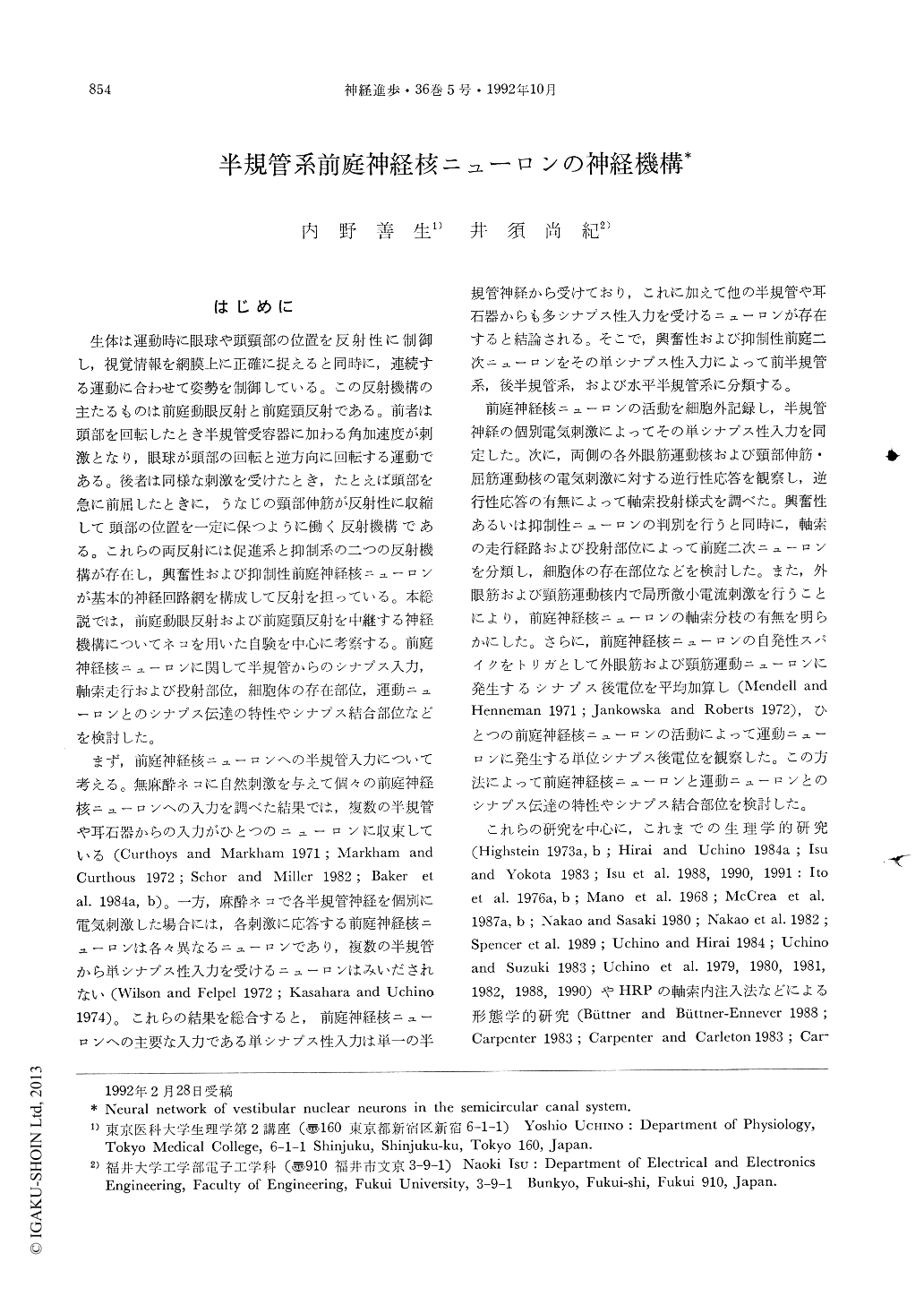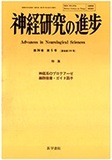Japanese
English
- 有料閲覧
- Abstract 文献概要
- 1ページ目 Look Inside
はじめに
生体は運動時に眼球や頭頸部の位置を反射性に制御し,視覚情報を網膜上に正確に捉えると同時に,連続する運動に合わせて姿勢を制御している。この反射機構の主たるものは前庭動眼反射と前庭頸反射である。前者は頭部を回転したとき半規管受容器に加わる角加速度が刺激となり,眼球が頭部の回転と逆方向に回転する運動である。後者は同様な刺激を受けたとき,たとえば頭部を急に前屈したときに,うなじの頸部伸筋が反射性に収縮して頭部の位置を一定に保つように働く反射機構である。これらの両反射には促進系と抑制系の二つの反射機構が存在し,興奮性および抑制性前庭神経核ニューロンが基本的神経回路網を構成して反射を担っている。本総説では,前庭動眼反射および前庭頸反射を中継する神経機構についてネコを用いた自験を中心に考察する。前庭神経核ニューロンに関して半規管からのシナプス入力,軸索走行および投射部位,細胞体の存在部位,運動ニューロンとのシナプス伝達の特性やシナプス結合部位などを検討した。
まず,前庭神経核ニューロンへの半規管入力について考える。無麻酔ネコに自然刺激を与えて個々の前庭神経核ニューロンへの入力を調べた結果では,複数の半規管や耳石器からの入力がひとつのニューロンに収束している(Curthoys and Markham 1971;Markham and Curthous 1972;Schor and Miller 1982;Baker et a1.1984a,b)。一方,麻酔ネコで各半規管神経を個別に電気刺激した場合には,各刺激に応答する前庭神経核ニューロンは各々異なるニューロンであり,複数の半規管から単シナプス性入力を受けるニューロンはみいだされない(Wilson and Felpel 1972;Kasahara and Uchino 1974)。これらの結果を総合すると,前庭神経核ニューロンへの主要な入力である単シナプス性入力は単一の半規管神経から受けており,これに加えて他の半規管や耳石器からも多シナプス性入力を受けるニューロンが存在すると結論される。そこで,興奮性および抑制性前庭二次ニューロンをその単シナプス性入力によって前半規管系,後半規管系,および水平半規管系に分類する。
This review summarized the axonal pathways, projecting targets, somatic location, synaptic properties, and synaptic terminals of vestibular nuclear neurons concerned with the vestibulo-ocular and/or vesti-bulo-collic reflexes. Excitatory secondary vestibular neurons in the anterior, posterior, and horizontal canal systems include vestibulo-oculo-collic neurons which relay both the vestibulo-ocular and vestibulo-collie reflexes, as well as vestibulo-ocular and vestibulo-collic neurons which relay either reflex. Inhibi-tory secondary vestibular neurons in the horizontal canal system include vestibulo-occulo-collic neurons, while those in the vertical canal systems do not. It was suggested that both excitatory and inhibitory vestibular nuclear neurons form synapses mainly on the cell somata and/or proximal dendritres of extra-ocular and neck motoneurons, and that inhibitory vestibulo-ocular neurons form synapses also on the distal dendrites as well. Vestibular neurons exhibite a low rate of synaptic contacts on extraocular motoneurons widely scattered over the motor muclei, and a high rate of contacts on neck motoneurons localized within a narrow area.

Copyright © 1992, Igaku-Shoin Ltd. All rights reserved.


